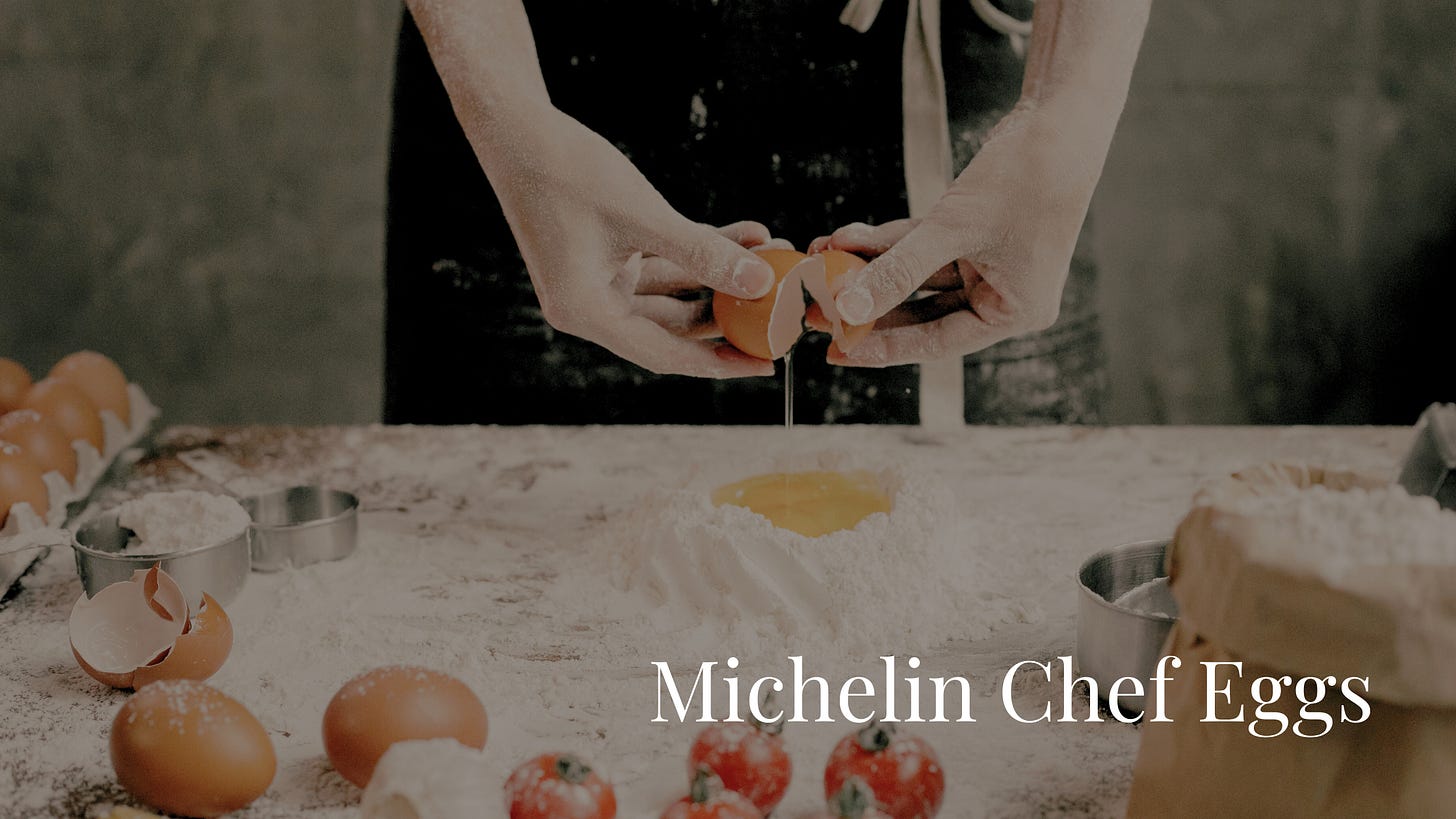What’s the Secret to Perfect Eggs? Here’s How Michelin Chefs Do It!
Master the art of eggs—whether scrambled, poached, or fried—with Michelin-level techniques that elevate every bite
Do you remember that movie Runaway Bride with Julia Roberts and Richard Gere? How her whole personality changed as did her breakfast egg preferences with each personality and guy change? Egg preferences seem to be that particular per person.
Some like them soft and velvety, others crispy and golden. But have you ever wondered how Michelin-starred chefs get their eggs just right every time? Whether it’s the fluffiest scrambled eggs, the perfect poached yolk, or a crispy-edged fried egg, mastering eggs is an essential culinary skill—one that separates the home cook from the professional chef.
So, how do they do it? Let’s break down the techniques that top chefs swear by to elevate this simple ingredient into something extraordinary.
How to Cook Eggs Like a Michelin Chef
Whether you're crafting the perfect brunch experience or refining your kitchen's efficiency, these Michelin-level techniques will ensure consistency and excellence. Impress your guests with eggs cooked to perfection, whether in a fine-dining setting or a boutique café.
➡️ Pro Tip: Consider adding variations like Eggs Florentine or Shakshuka to your menu for a unique, global brunch selection.
Eggs might seem simple, but cooking them perfectly is an art. Michelin-starred chefs treat eggs with precision, understanding their structure and mastering techniques to achieve restaurant-quality textures. Whether you love them scrambled, poached, soft-boiled, or fried, here’s how to elevate your egg game to a professional level.
1. Scrambled Eggs: Creamy, Soft, and Luxurious
Michelin chefs don’t just scramble eggs—they create velvety, custard-like perfection.
✔️ Low and Slow is the Key – Cook over low heat, stirring constantly to prevent curdling. ✔️ Butter, Not Oil – Butter adds richness and keeps the texture silky. ✔️ No Salt Until the End – Salting early tightens the proteins, making them less creamy. ✔️ Finish with Cream or Crème Fraîche – A touch at the end enhances the smooth texture.
➡️ Chef’s Tip: Use a heatproof spatula to gently fold the eggs rather than a whisk.
2. Poached Eggs: Perfect Yolks Every Time
Poached eggs might be intimidating, but with the right method, they’re foolproof.
✔️ Use Fresh Eggs – Older eggs have watery whites that won’t hold together well. ✔️ Swirl the Water – A gentle vortex helps wrap the egg whites around the yolk. ✔️ Vinegar Helps – A small splash in simmering water helps the whites coagulate faster. ✔️ No Boiling! – Keep the water at a gentle simmer (180–190°F / 82–88°C).
➡️ Chef’s Tip: Crack the egg into a small bowl before lowering it into the water for better control.
3. Soft-Boiled Eggs: The Perfect Jammy Center
(Also known as 'dippy eggs' in England, often served with toast soldiers for dipping.)
A Michelin-style soft-boiled egg has a firm white with a luscious, runny yolk.
✔️ 6 Minutes for Perfection – Simmer eggs for exactly 6 minutes, then transfer to ice water. ✔️ Peel Carefully – Roll the egg gently on the counter to crack the shell, then peel under running water. ✔️ Use for Ramen or Avocado Toast – The creamy yolk makes everything better.
➡️ Chef’s Tip: If you prefer a slightly firmer yolk, go for 7 minutes instead.
4. Fried Eggs: Crispy Edges, Runny Center
A perfectly fried egg has lacy, crispy edges with a beautifully runny yolk.
✔️ Use a Cast Iron or Nonstick Pan – A hot pan ensures crispiness without sticking. ✔️ More Oil = Crispier Edges – Baste the egg with hot oil to cook the top without flipping. ✔️ Low Heat for Soft Yolks, Medium-High for Firm Yolks – Adjust heat based on your preference. ✔️ Season at the End – Salt too early can make the eggs weep moisture.
🛠 Best Skillets for Cooking Eggs:
Nonstick Skillet – Best for scrambled eggs and easy cleanup, prevents sticking without excess fat.
Cast Iron Skillet – Retains heat well, great for crispy fried eggs with lacy edges.
Stainless Steel Pan – Perfect for achieving a crispy sear on fried eggs but requires proper preheating and oiling.
➡️ Chef’s Tip: Want a basted egg without flipping? Cover the pan for 30 seconds to gently steam the top.
A perfectly fried egg has lacy, crispy edges with a beautifully runny yolk.
✔️ Use a Cast Iron or Nonstick Pan – A hot pan ensures crispiness without sticking. ✔️ More Oil = Crispier Edges – Baste the egg with hot oil to cook the top without flipping. ✔️ Low Heat for Soft Yolks, Medium-High for Firm Yolks – Adjust heat based on your preference. ✔️ Season at the End – Salt too early can make the eggs weep moisture.
➡️ Chef’s Tip: Want a basted egg without flipping? Cover the pan for 30 seconds to gently steam the top.
🎥 Watch Gordon Ramsay’s Guide to Perfect Scrambled & Fried Eggs
5. The Perfect Omelet: French vs. American Style
Not all omelets are created equal! A French omelet is soft, smooth, and custardy, while an American omelet is fluffy, golden, and packed with fillings. Master both styles like a Michelin chef.
✔️ French Omelet – Cook over low heat, stir constantly, and roll it into a smooth, tender fold.
✔️ American Omelet – Use medium heat, allow it to set, and fill with cheese, herbs, or veggies before folding.
✔️ The Right Pan – A nonstick skillet works best for delicate French omelets, while a cast iron gives American omelets a firmer edge.
🎥 Watch Parker Hallberg’s Michelin-Style Omelet Tutorial:
Eggs might seem simple, but perfecting them is an art. What’s your go-to way to cook eggs? Do you prefer the velvety smoothness of scrambled eggs, the crispiness of a fried egg, or the classic indulgence of Eggs Benedict? Let’s talk eggs in the comments!
Not Your Grandmother’s Recipe Cards
Signature Series February Edition
If you want it, buy this recipe card now…before the price goes up March 1st!
Not what you are looking for? Go to The Earth & Flame Shoppe to see all of the recipe cards, checklists and menu designs are I’m constantly coming out with new designs.
Bundles are coming soon!
Want to Work Together? Here’s How I Can Help:
Looking to elevate your hospitality offerings, refine your food content, or create standout menus? Here’s how we can work together: ✔️ Consulting for Restaurants & Hospitality Businesses – Improve menu design, storytelling, and guest experience. ✔️ Content Creation & Food Writing – Professional blog posts, newsletters, and engaging culinary storytelling. ✔️ Recipe & Menu Development – Custom menu planning with a focus on farm-to-table, wellness, and elevated dining.
🚧 Want to take your egg skills to the next level? We've mastered the basics—now let’s talk brunch classics! Unlock Michelin-level brunch dishes like Eggs Benedict, Shakshuka, and more by becoming a paid subscriber.
Keep reading with a 7-day free trial
Subscribe to The Earth & Flame to keep reading this post and get 7 days of free access to the full post archives.




